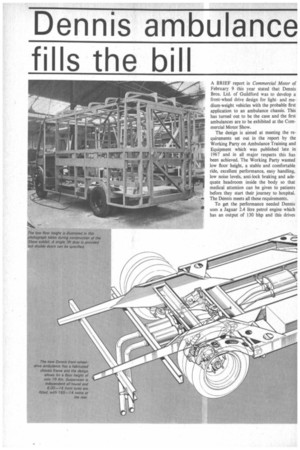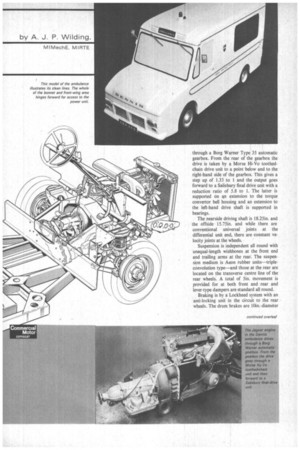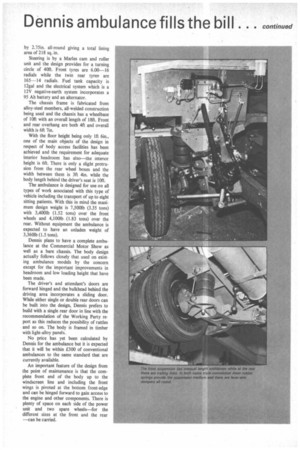Dennis ambulance
Page 118

Page 119

Page 120

If you've noticed an error in this article please click here to report it so we can fix it.
fills the bill
by A. J. P. Wilding,
MIMechE, MIRTE
A BRIEF report in Commercial Motor of February 9 this year stated that Dennis Bros. Ltd. of Guildford was to develop a front-wheel drive design for lightand medium-weight vehicles with the probable first application to an ambulance chassis. This has turned out to be the case and the first ambulances are to be exhibited at the Commercial Motor Show.
The design is aimed at meeting the requirements set out in the report by the Working Party on Ambulance Training and Equipment which was published late in 1967 and in all major respects this has been achieved. The Working Party wanted low floor height, a stable and comfortable ride, excellent performance, easy handling, low noise levels, anti-lock braking and adequate headroom inside the body so that medical attention can be given to patients before they start their journey to hospital. The Dennis meets all these requirements.
To get the performance needed Dennis uses a Jaguar 2.4 litre petrol engine which has an output of 130 bhp and this drives
through a Borg Warner Type 35 automatic gearbox. From the rear of the gearbox the drive is taken by a Morse Hi-Vo toothedchain drive unit to a point below and to the right-hand side of the gearbox. This gives a step up of 1.33 to 1 and the output goes forward to a Salisbury final drive unit with a reduction ratio of 5.8 to 1. The latter is supported on an extension to the torque convertor bell housing and an extension to the left-hand drive shaft is supported in bearings.
The nearside driving shaft is 18.25 in. and the offside 15.75in. and while there are conventional universal joints at the differential unit end, there are constant velocity joints at the wheels.
Suspension is independent all round with unequal-length wishbones at the front end and trailing arms at the rear. The suspension medium is Aeon rubber units—tripleconvolution type—and those at the rear are located on the transverse centre line of the rear wheels. A total of 5in movement is provided for at both front and rear and lever-type dampers are standard all round.
Braking is by a Lockheed system with an anti-locking unit in the circuit to the rear wheels. The drum brakes are 10in.-diameter by 2.75in. all-round giving a total lining area of 218 sq. in.
Steering is by a Manes cam and roller unit and the design provides for a turning circle of 40ft. Front tyres are 6.00-16 radials while the twin rear tyres are 165-14 radials. Fuel tank capacity is 12gal and the electrical system which is a 12V negative-earth system incorporates a 95 Ah battery and an alternator.
The chassis frame is fabricated from alloy-steel members, all-welded construction being used and the chassis has a wheelbase of 10ft with an overall length of 18ft. Front and rear overhang are both 4ft and overall width is 6ft 7in.
With the floor height being only lft 6in., one of the main objects of the design in respect of body access facilities has been achieved and the requirement for adequate interior headroom has also—the intenor height is 6ft. There is only a slight protrusion from the rear wheel boxes and the width between them is 3ft 4in. while the body length behind the driver's seat is 10ft.
The ambulance is designed for use on all types of work associated with this type of vehicle including the transport of up to eight sitting patients. With this in mind the maximum design weight is 7,5001b (3.35 tons) with 3,4001b (1.52 tons) over the front wheels and 4,1001b (1.83 tons) over the rear. Without equipment the ambulance is expected to have an unladen weight of 3,3601b (1.5 tons).
Dennis plans to have a complete ambulance at the Commercial Motor Show as well as a bare chassis. The body design actually follows closely that used on existing ambulance models by the concern except for the important improvements in headroom and low loading height that have been made.
The driver's and attendant's doors are forward hinged and the bulkhead behind the driving area incorporates a sliding door. While either single or double rear doors can be built into the design, Dennis prefers to build with a single rear door in line with the recommendation of the Working Party report as this reduces the possibility of rattles and so on. The body is framed in timber with light-alloy panels.
No price has yet been calculated by Dennis for the ambulance but it is expected that it will be within £300 of conventional ambulances to the same standard that are currently available.
An important feature of the design from the point of maintenance is that the complete front end of the body up to the windscreen line and including the front wings is pivoted at the bottom front-edge and can be hinged forward to gain access to the engine and other components. There is plenty of space on each side of the power unit and two spare wheels—for the different sizes at the front and the rear —can be carried.




































































































































































































































































